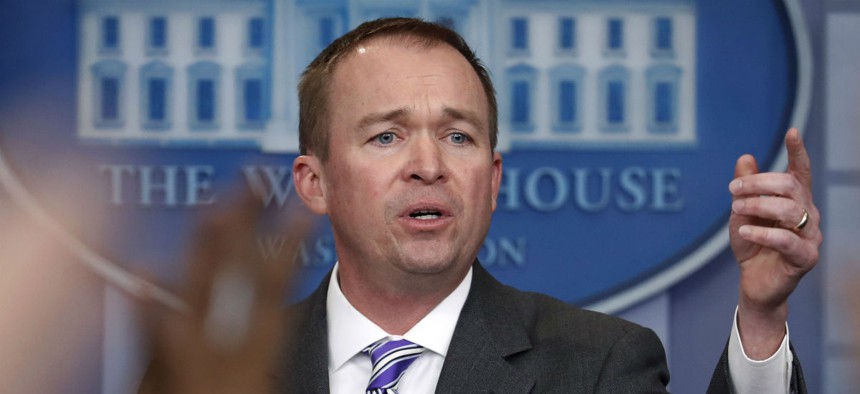Trump Budget to Leave Workforce Cuts Up to Agencies
Plan slashes spending at non-Defense agencies as expected; wasn’t written “with an eye toward the value of your [D.C.-area] condo,” Mulvaney says.
President Trump’ first budget set for release Thursday morning translates candidate Trump’s “America First” themes into numbers, aiming to “shrink the role of government, drive efficiencies and go after waste” while hiking spending on defense and border security.
Budget Director Mick Mulvaney on Wednesday called the “skinny” document a “hard power budget, not a soft power budget, which sends a message to our enemies and our allies.” That means a proposed 10 percent, or $54 billion, boost to Defense-related programs in fiscal 2018, a 6 percent boost for Homeland Security, and cuts “where you’d expect” at many other agencies, he said.
The State Department, for instance, will see a 28 percent cut, though that is less than the 37 percent decrease to State and the U.S. Agency for International Development circulated in news reports Mulvaney called “not accurate.” There will also be “significant cuts” at the Environmental Protection Agency,” he said.
Any cuts in the federal workforce resulting from the spending decreases, Mulvaney said, will be determined by agency heads “with more discretion than is typical for an agency.” But when asked for numbers and the possible impact on the Washington economy, the head of the Office of Management and Budget told a reporter, “The president represents the District of Columbia, but the president also represents the rest of America, so we did not write this budget with an eye toward the value of your condo.”
The brief opening “budget blueprint” for fiscal 2018—which will be fleshed out in May—was written using “the president’s own words” after OMB staff went through Trump’s campaign speeches “and turned policies into numbers,” Mulvaney said. Unlike a full budget, it does not provide long analysis and policy descriptions, nor does it address tax policy and the entitlement programs that represent a larger portion of the $4 trillion federal budget than the $1 trillion in discretionary spending.
Also, the first Trump submission “does not balance,” Mulvaney acknowledged. It provides “no spreadsheets or 10-year-window” for analysis of projections, and will not have anything on the currently debated health care reform legislation, he said. But unlike the budgets of past administrations, he said, the submission avoids further borrowing and adding to the projected $488 billion through “offsets” elsewhere arrived at “holistically.”
Along with the fiscal 2018 rough budget, OMB will also release its recommendations for the fiscal 2017 budget that Congress must finalize by April 28. This will include a request for a $30 billion supplemental, including $1.5 billion to build the wall along the U.S.-Mexico border that Trump discussed so much during the 2016 campaign.
Spending on the controversial wall, which will be taken from “general Treasury funds” will begin with pilot programs within the Homeland Security Department since “we don’t know the number of miles or the type of construction,” Mulvaney said, allowing for a raise to $2.6 billion in fiscal 2018.
The huge cuts at the State Department in the fiscal 2018 proposal revolve around foreign aid, Mulvaney said. “It’s not a comment on president’s attitude toward State but toward its budget, and foreign aid happens to be in State’s budget,” he said, adding that Trump has full confidence in the work of Secretary of State Rex Tillerson.
The hikes in defense spending were planned with DoD officials “in a responsible fashion around the needs and what they can spend efficiently,” the budget director said. “They’re not throwing money at a problem.
At EPA, he said, OMB worked with new administrator Scott Pruitt “so that core functions will be satisfied” during the “pass-back” process, though it will be up to Pruitt to “implement the top-line numbers.” People “can expect significant cuts in areas that don’t line up with the president’s priorities,” which, he said, includes programs related to global warming and alternative energy.
At Housing and Urban Development, Mulvaney’s team worked with Secretary Ben Carson to identify “waste and duplicative programs that don’t work. HUD has spent a lot in the past 10 years without a lot to show for it,” the budget director added. Trump’s much-discussed concerns for the inner cities will likely be addressed in the Education Department, Mulvaney said.
The budget proposed for NASA contains an overall 1 percent cut in the top line, Mulvaney said, but some program funds have been moved to fund exploration of other planets and other projects.
“Don’t discount the infrastructure program” that Trump should deliver later this year, Mulvaney said, noting that Transportation may see some cuts that will be restored under the infrastructure plan.
The Corporation for Public Broadcasting, he acknowledged under questioning, will see its funds eliminated. But “it won’t be a zero amount” in the first year, he said, because “we have to unwind our involvement with the CPB,” which might take a year or two.




